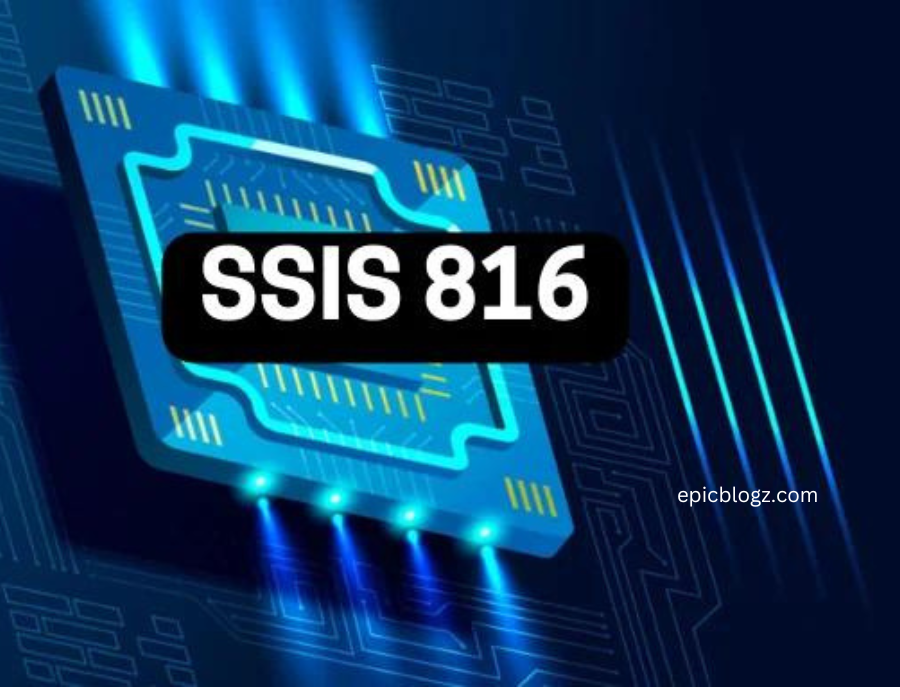Introduction
In today’s data-driven world, organizations handle enormous volumes of information, often scattered across different systems, databases, and formats. Successfully integrating these diverse data sources is essential for businesses to function efficiently and make informed decisions. One of the most powerful tools for achieving seamless data integration is SQL Server Integration Services (SSIS), and its SSIS-816 version has gained particular attention for its comprehensive features and capabilities. The SSIS-816 advantage lies in its ability to transform, consolidate, and streamline data integration tasks like never before.
What is SSIS-816?
SSIS-816 is the latest version of SQL Server Integration Services, a component of Microsoft SQL Server that enables data migration and transformation processes. SSIS is a highly flexible and scalable tool that can handle a variety of data integration tasks, including:
- Extract, Transform, Load (ETL): Extracting data from multiple sources, transforming it into the desired format, and loading it into a target system or database.
- Data Warehousing: Integrating data from disparate sources into a unified data warehouse.
- Business Intelligence (BI): Empowering decision-making through consolidated, accurate, and up-to-date information.
The SSIS-816 version adds several advanced features that enhance performance, security, and ease of use, making it a valuable asset for businesses looking to optimize their data workflows.
Why Data Integration is Essential for Businesses
Before diving into the specific benefits of SSIS-816, it’s important to understand why data integration is so critical in today’s business landscape. The primary goal of data integration is to bring together disparate data sources to provide a unified view, helping organizations:
- Improve Decision Making: When data from various departments and systems is unified, businesses can make more informed decisions based on comprehensive insights.
- Enhance Efficiency: By automating data flows, integration reduces manual input and the risk of errors, making processes more efficient.
- Maintain Data Consistency: Data integration ensures that information is consistent across all platforms, reducing redundancy and discrepancies.
- Optimize Operations: Unified data enables smoother operations, ensuring that all departments work with the same, up-to-date information.
Mastering data integration with SSIS-816 enables organizations to achieve these goals by providing a robust, user-friendly platform for managing complex data tasks.
Key Features of SSIS-816
SSIS-816 stands out in the data integration landscape due to several advanced features that address the evolving needs of businesses. Below are the most notable capabilities of SSIS-816:
1. Advanced Data Flow Components
SSIS-816 comes equipped with enhanced data flow components that streamline the ETL process. These components allow users to:
- Perform Complex Transformations: SSIS-816 offers tools for data cleansing, sorting, filtering, and aggregation, allowing users to manipulate data according to business needs.
- Work with Diverse Data Sources: Whether your data is stored in a cloud database, a traditional SQL Server, or a flat file, SSIS-816 can seamlessly extract and integrate it.
- Parallel Processing: To improve performance, SSIS-816 supports parallel processing, ensuring that data integration tasks are executed faster, even with large data volumes.
2. Improved Scalability
The SSIS-816 version offers improved scalability, which is particularly useful for enterprises that handle vast amounts of data or expect to scale their operations in the future. With its ability to manage and process data from multiple sources simultaneously, SSIS-816 can scale to meet the needs of growing businesses.
3. Built-In Security Features
Data security is a top priority in today’s regulatory landscape, and SSIS-816 provides several built-in features to ensure that sensitive information is protected. Key security features include:
- Data Encryption: Data can be encrypted both during storage and transit, ensuring compliance with data protection regulations such as GDPR.
- Role-Based Access Control (RBAC): Only authorized users can access, modify, or manage data, preventing unauthorized access.
- Auditing and Logging: SSIS-816 enables detailed logging and auditing of data integration processes, allowing businesses to track changes and ensure data integrity.
4. Integration with Cloud Services
With businesses increasingly relying on cloud platforms, SSIS-816’s ability to integrate with services like Azure and AWS is a major advantage. Users can easily extract, transform, and load data from cloud environments, ensuring smooth hybrid or cloud-native operations.
5. Visual Studio Integration for Development
Developers will appreciate SSIS-816’s seamless integration with Visual Studio, which provides a robust and familiar environment for creating, testing, and deploying data integration packages. This integration simplifies complex workflows and accelerates development times.
How SSIS-816 Enhances ETL Processes
ETL—Extract, Transform, Load—is the backbone of data integration, and SSIS-816 offers a number of features that make ETL processes more efficient, reliable, and flexible. Let’s break down the ETL process within SSIS-816 to understand its advantages:
1. Extracting Data from Multiple Sources
In any data-driven organization, data comes from a wide variety of sources, such as SQL databases, flat files, web services, and even social media platforms. SSIS-816 simplifies the extraction of data from these disparate sources by providing a range of pre-built connectors and components. Whether your data resides on-premises or in the cloud, SSIS-816 can extract it with ease.
2. Transforming Data Efficiently
Once data is extracted, transforming it into a usable format is key to ensuring consistency and accuracy. SSIS-816’s advanced transformation components allow you to:
- Perform Data Cleansing: Remove duplicates, null values, and other errors to ensure high-quality data.
- Standardize Formats: Align data from different sources to a common format to facilitate analysis and reporting.
- Enrich Data: Enhance your data by merging it with external datasets, applying business rules, or performing calculations.
3. Loading Data Into Target Systems
SSIS-816 ensures that data is loaded into the target systems—whether it’s a data warehouse, operational database, or analytics platform—efficiently and without errors. The tool supports bulk data loading, which improves speed and reduces system load during high-volume data migrations.
Best Practices for Mastering SSIS-816
To fully harness the power of SSIS-816, there are several best practices that data professionals should follow. These guidelines will help ensure that your data integration processes are optimized for performance, reliability, and security.
1. Plan and Document Your ETL Workflows
Before building any ETL package in SSIS-816, it’s essential to plan out the data flow, transformations, and final outputs. Documenting your process will help avoid potential errors and ensure that future modifications are easy to implement.
2. Optimize Data Flow Tasks
To enhance performance, make use of SSIS-816’s parallel processing capabilities and ensure that data flow tasks are optimized for speed. Avoid unnecessary transformations that could slow down the integration process.
3. Monitor and Audit Data Integration Jobs
SSIS-816 provides powerful logging and auditing tools. These should be used to track the progress of your data integration jobs and to quickly identify any issues. Set up alerts and notifications for failed jobs so that problems can be resolved immediately.
4. Implement Robust Error Handling
Unexpected errors can occur during any data integration process. To prevent data loss or corruption, use SSIS-816’s error handling components, such as error rows redirection and event handling, to manage issues effectively.
5. Secure Your Data
Given the importance of data security, always implement encryption where necessary, and limit access to your SSIS-816 packages to authorized personnel only. Make use of SSIS’s security features to protect sensitive information during processing.
SSIS-816 vs. Other Data Integration Tools
While there are several data integration tools available, SSIS-816 provides several advantages over other platforms, including Talend, Informatica, and Apache NiFi. Here’s how SSIS-816 compares:
1. Seamless Integration with Microsoft Ecosystem
SSIS-816 integrates smoothly with other Microsoft products like SQL Server, Azure, and Power BI, making it ideal for businesses already invested in the Microsoft ecosystem.
2. Flexibility Across Platforms
Unlike some competitors, It can work with both on-premises and cloud-based data sources, giving businesses more flexibility in their data management strategies.
3. Cost-Effectiveness
As part of SQL Server, It offers a cost-effective solution for data integration, especially for organizations that already use SQL Server for their database management.
4. User-Friendly Interface
SSIS-816 provides a user-friendly interface with drag-and-drop components, making it accessible even to those who may not have advanced coding skills.
Future of Data Integration with SSIS-816
As businesses continue to digitize their operations, the need for efficient, reliable, and scalable data integration tools will only grow. It is well-positioned to meet these demands with its robust features and flexibility. Looking ahead, several trends are likely to shape the future of data integration, and it is ready to evolve alongside them:
1. AI and Machine Learning Integration
In the near future, expect it to integrate more seamlessly with AI and machine learning tools, enabling businesses to derive even deeper insights from their data.
2. Increased Cloud Adoption
As more businesses move their operations to the cloud, SSIS-816’s cloud integration capabilities will continue to improve, making it easier to manage hybrid data environments.
3. Focus on Real-Time Data Processing
With the rise of IoT and real-time data applications, It will continue to evolve to handle real-time data streams efficiently, ensuring businesses can make decisions based on the most current information available.
Conclusion
Mastering data integration is crucial for businesses to unlock the full potential of their data. The SSIS-816 advantage offers a comprehensive suite of tools designed to streamline the ETL process, improve scalability, and ensure security. By embracing SSIS-816, businesses can optimize their data integration workflows, enhance decision-making, and position themselves for future growth. Whether you are just starting with data integration or looking to refine your processes, It provides the features and flexibility needed to succeed in today’s data-driven world.
ALSO READ: https://gamemakerblog.net: Master Game Creation
FAQs
What is SSIS-816?
It is the latest version of SQL Server Integration Services, a data integration tool that helps businesses streamline ETL processes, manage large datasets, and improve overall data workflows.
How does It enhance data integration?
It offers advanced features like parallel processing, cloud integration, enhanced security, and built-in components for efficient ETL processes.
Can It handle real-time data?
Yes, It supports real-time data processing and is well-suited for handling streaming data from IoT devices or real-time analytics.
What are the key security features of it?
It includes data encryption, role-based access control, and detailed auditing tools to ensure data security and compliance with regulations.
How does It compare to other data integration tools?
It is highly integrated with Microsoft products, offers flexibility across platforms, and is more cost-effective for businesses already using SQL Server.
What is the role of ETL in data integration?
ETL—Extract, Transform, Load—is the process of extracting data from various sources, transforming it into a usable format, and loading it into a target system for analysis or reporting.







